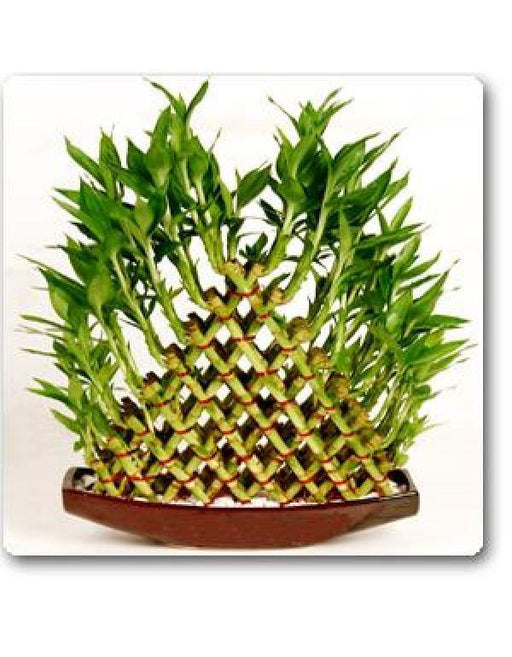▶ Scientific Name : Dracaena sanderiana
▶ About Lucky Bamboo Plant -
The Lucky Bamboo, also known as Dracaena sanderiana, is a popular houseplant that is believed to bring good luck and fortune to its owners. It is native to Central Africa but is now grown and sold all over the world. Lucky bamboo is a relatively low-maintenance plant, making it a good choice for people of all skill levels. It can be grown in soil or water and can tolerate a variety of light conditions.
The Lucky Bamboo is a beautiful and unique plant that can add a touch of elegance to any home. It is also a great gift for any occasion.
▶ Benefits of Lucky Bamboo
Aesthetic Appeal: The Lucky Bamboo is one of the best indoor plants for tabletop displays. Lucky bamboo has a unique appearance with its long, slender stalks, and luscious green leaves will adorn your tables and desks.
Having a lucky bamboo plant in your collection will be a great addition to elevate your corners, desks, and center tables. This plant can be adaptable to any setting so you can decorate any space with lucky bamboo with no worries!
Easy to Grow: Lucky Bamboo are less demanding plant. They require minimal maintenance.
Grow Without Soil: Lucky bamboo plants don't necessarily need to be potted. They can grow in water bowls or containers.
Perfect for Any Space: Lucky bamboo plants are perfect for any setting, this plant is suitable for bedrooms, living rooms, apartments, balconies, and patios.
▶ Quick Care Tips for Your Lucky Bamboo
☀️Light: Lucky bamboo plants prefer bright indirect sunlight. Harsh sunlight can burn their leaves.
💧Watering: Water regularly when the 1-2 inches of the soil is dry. Remove standing water from the saucer. Over-watering leads to root rot so avoid watering your Lucky Bamboos.
🪴Soil: For Lucky Bamboo to thrive, use well-drained, nutrient-rich soil and keep it moist without over-soaking.( if you are planting in soil)
🌡️Temperature: The ideal temperature range for Lucky Bamboo is between 65–95°F (18–35°C).
🪴Container: To prevent the Lucky Bamboo from tipping over, add some rocks to the container as an anchor. Clean the container every few months and replace the water once or twice a week to prevent the formation of algae.
✂️Pruning: Prune or trim dead and brown leaves, pinching and trimming your Lucky Bamboos will allow them to grow bushier.
🐜Pests: Common pests that may attack Lucky Bamboo are mealybugs, mites, and fungi. If you see a grey fuzz on the plant, it may indicate a fungal infection. In such cases, remove the infected parts, keep the leaves and stalk dry, and ensure proper air circulation.
🐱Not Pet-Friendly: Lucky Bamboo is toxic to cats and dogs. Keep it out of their reach.
▶Significance & Symbolism of Lucky Bamboo
Popular in Japanese and Chinese cultures, lucky bamboo plants' symbolism varies on the number of stalks in the arrangement. Here is a brief overview of the most common interpretations:
- 1 stalk: represents unity, new beginnings, and a strong life force.
- 2 stalks: represent love, luck, and double happiness.
- 3 stalks: represent happiness, wealth, and longevity.
- 4 stalks: represents balance, stability, and good foundation.
- 5 stalks: represents wealth, prosperity, and abundance.
- 6 stalks: represents good luck, prosperity, and smooth sailing.
- 7 stalks: represents good health and vitality.
- 8 stalks: represent growth, wealth, and prosperity.
- 9 stalks: represents great luck and all-around good fortune.
- 10 stalks: represents perfection and completeness.
For example, if you want to improve your wealth and prosperity, you might place a lucky bamboo arrangement with five stalks. If you want to improve your health and vitality, you might place a lucky bamboo arrangement with seven stalks.
No matter how you choose to display it, lucky bamboo is a beautiful and auspicious plant that is sure to bring good fortune into your life.










